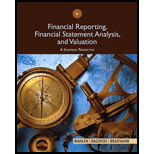
Financial Reporting, Financial Statement Analysis and Valuation
8th Edition
ISBN: 9781285190907
Author: James M. Wahlen, Stephen P. Baginski, Mark Bradshaw
Publisher: Cengage Learning
expand_more
expand_more
format_list_bulleted
Textbook Question
Chapter 12, Problem 6QE
Suppose you are valuing a healthy, growing, profitable firm and you project that the firm will generate negative
Expert Solution & Answer
Want to see the full answer?
Check out a sample textbook solution
Students have asked these similar questions
Need help !
In financial terms, liquidity refers to:
A. Profitability of an investmentB. Ability to meet short-term obligationsC. Long-term solvencyD. Market value of equity
need answer
In financial terms, liquidity refers to:
A. Profitability of an investmentB. Ability to meet short-term obligationsC. Long-term solvencyD. Market value of equity
Need help!
Which type of risk cannot be eliminated through diversification?
A. Market riskB. Credit riskC. Operational riskD. Unsystematic risk
Chapter 12 Solutions
Financial Reporting, Financial Statement Analysis and Valuation
Knowledge Booster
Learn more about
Need a deep-dive on the concept behind this application? Look no further. Learn more about this topic, finance and related others by exploring similar questions and additional content below.Similar questions
- Which type of risk cannot be eliminated through diversification? A. Market riskB. Credit riskC. Operational riskD. Unsystematic riskarrow_forwardThe term "leverage" in finance refers to: A. Use of debt to increase potential returnsB. Investing in high-risk securitiesC. Paying off liabilitiesD. Issuing new shares need step by step.arrow_forwardDon't use chatgpt, i need help! The term "leverage" in finance refers to: A. Use of debt to increase potential returnsB. Investing in high-risk securitiesC. Paying off liabilitiesD. Issuing new sharesarrow_forward
- I need help in this question! The term "leverage" in finance refers to: A. Use of debt to increase potential returnsB. Investing in high-risk securitiesC. Paying off liabilitiesD. Issuing new sharesarrow_forwardNeed help! The term "leverage" in finance refers to: A. Use of debt to increase potential returnsB. Investing in high-risk securitiesC. Paying off liabilitiesD. Issuing new sharesarrow_forwardThe term "leverage" in finance refers to: A. Use of debt to increase potential returnsB. Investing in high-risk securitiesC. Paying off liabilitiesD. Issuing new sharesarrow_forward
- Don't use chatgpt! What is the formula of net persent values ? explain.arrow_forwardNeed answer ! If the Net Present Value (NPV) of a project is positive, it indicates: A. The project is unprofitableB. The project is financially viableC. The project has no riskD. The project will increase costsarrow_forwardDon't use chatgpt! Which of the following refers to the rate at which one currency is exchanged for another? A. Interest rateB. Exchange rateC. Inflation rateD. Capitalization ratearrow_forward
- i need help in this question. Which of the following refers to the rate at which one currency is exchanged for another? A. Interest rateB. Exchange rateC. Inflation rateD. Capitalization ratearrow_forwardWhat is the formula of net persent values ? explain.arrow_forwardIf the Net Present Value (NPV) of a project is positive, it indicates: A. The project is unprofitableB. The project is financially viableC. The project has no riskD. The project will increase costsarrow_forward
arrow_back_ios
SEE MORE QUESTIONS
arrow_forward_ios
Recommended textbooks for you
 Financial Reporting, Financial Statement Analysis...FinanceISBN:9781285190907Author:James M. Wahlen, Stephen P. Baginski, Mark BradshawPublisher:Cengage Learning
Financial Reporting, Financial Statement Analysis...FinanceISBN:9781285190907Author:James M. Wahlen, Stephen P. Baginski, Mark BradshawPublisher:Cengage Learning Intermediate Financial Management (MindTap Course...FinanceISBN:9781337395083Author:Eugene F. Brigham, Phillip R. DavesPublisher:Cengage Learning
Intermediate Financial Management (MindTap Course...FinanceISBN:9781337395083Author:Eugene F. Brigham, Phillip R. DavesPublisher:Cengage Learning

Financial Reporting, Financial Statement Analysis...
Finance
ISBN:9781285190907
Author:James M. Wahlen, Stephen P. Baginski, Mark Bradshaw
Publisher:Cengage Learning

Intermediate Financial Management (MindTap Course...
Finance
ISBN:9781337395083
Author:Eugene F. Brigham, Phillip R. Daves
Publisher:Cengage Learning

FIN 300 Lab 1 (Ryerson)- The most Important decision a Financial Manager makes (Managerial Finance); Author: AllThingsMathematics;https://www.youtube.com/watch?v=MGPGMWofQp8;License: Standard YouTube License, CC-BY
Working Capital Management Policy; Author: DevTech Finance;https://www.youtube.com/watch?v=yj-XbIabmFE;License: Standard Youtube Licence